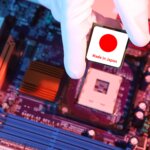Just a sleeping giant? Japan ready to reclaim semiconductor superstardom
- Japan used to be a giant in the semiconductor industry.
- The competition for semiconductor dominance has hotted up alongside the chip war between the US and China.
- Government subsidies alone won’t be enough for Japan to reclaim its old industry status.
The semiconductor market is projected to reach $1 trillion by 2030 and governments around the world are implementing initiatives to secure access to chips – the fight between China and the US proving the necessity of insulating supply chains from geopolitical tensions.
In 2023, Japan went all in. The government backed new plans and rolled out extensive support: the cherry on the cake of Japan’s efforts is government-backed Rapidus, pushing to create a rival to Silicon Valley away from California, a “Hokkaido Valley.”
Atsuyoshi Koike, president of Rapidus, breaks ground during a ceremony in Chitose, Hokkaido, on Sept. 1, 2023. Image via KYODO.
The Japanese government is trying to attract big players like ASML Holding; already piling in are Taiwan Semiconductor Manufacturing, Samsung Electronics and Mitsubishi Chemical Group. Successfully drawing in these semiconductor giants has cost tens of billions, even trillions, of yen.
And that value, coupled with the strategic importance of semiconductor self-sufficiency, means big challenges face Japan. Of course, every country aiming for the same goal has those problems too. While for many, this is expansion into new waters, Japan’s situation is unique: it’s trying to return to a former glory, the semiconductor dominance it once had.
In the 1980s and 90s, Japan was one of the biggest semiconductor players globally, maintained by government and private sector investment. In 1988, Japanese firms accounted for 51% of semiconductor sales worldwide.
TSMC in Kikuyo, May 2023. Image via Bloomberg.
The successes of Japan became the blueprint for countries like Malaysia, Taiwan and South Korea, which also needed economic development but lacked natural resources, according to Pierre Cambou, the principal analyst for semiconductor market analysis firm Yole Group.
Its downfall sounds somewhat familiar: tensions with the US, officials accusing Japanese firms of flooding the market and pushing out players, America using its geopolitical sway to cut off access to the Japanese market, making room for competitors – including South Korea – to make gains.
In 1986, the US-Japan Semiconductor Agreement gave American officials price-setting oversight and enabled access to Japan’s semiconductor market. Everything shifted, Japanese firms lost their competitive edge and by 2021, Japan was estimated to account for only 7% of semiconductor production.
China’s current reluctance to cut a deal with the US makes a bit more sense now.
In fact, the tensions between America and China have played a role in Japan’s effort to return to its former glory. American efforts to constrain China’s chipmaking capabilities have led to a range of restrictions on related exports by Washington and its allies, and caused a shakeup of industry supply chains.
“Considering the ongoing geopolitical risks, such as the US-China issue, it is likely that the Japanese government has made the decision to secure a strategically significant semiconductor production base in the region, partly in response to industry demands,” said Jun Okamoto, KPMG Japan’s industrial manufacturing lead.
Japan reclaims semiconductor industry relevancy
To boost Japan’s position in the semiconductor industry, Prime Minister Fumio Kishida has made an effort to communicate with the heads of top firms and associations in the industry to further coax investment and bolster Japan’s position.
The government is also handing out major subsidies: in December, it was revealed that Samsung would receive subsidies to open a chip packaging facility in Yokohama. The government will contribute around ¥20 billion ($135 million) — around half of the lab’s cost.
Okamoto said that while the Ministry of Economy, Trade and Industry “aims to attract cutting-edge technologies such as edge AI, power semiconductors and photonics systems,” Japan will have to develop its own capabilities in these areas first.
In 2022, the country launched the Leading-edge Semiconductor Technology Center to serve as an R&D hub. The goal for officials is an increase in annual semiconductor revenue to more than ¥13 trillion by 2030.
Challenges to Japan’s journey
A key concern in Japan achieving a place as a globally compelling semiconductor hub is private investment. While government support – which comes in the form of land grants, tax exemptions, subsidies and import restrictions – is key, profitable companies will have to follow suit.
Beyond achieving the necessary funds, a qualified workforce is crucial to the process. Okamoto believes this can be done “through collaborative efforts between industry, government and academia.”
Human capital (or “People” for all the non-economists in the room), including engineers and technicians, is something that countries looking to become chipmaking hubs should focus on. To do so, schools would prioritize science, technology, engineering and math.
Once a capable workforce has been built, wither by education or upskilling, constant R&D and investment will also be required.
There’s a reality to establishing semiconductor hubs that will also have to be dealt with. TSMC’s Kumamoto plant is struggling with water and staffing shortages. Closely linked with this, as plants descend on towns across Japan, are sustainability targets.
Sustainability is another area in wich Japan has fallen behind; securing interest from large overseas companies is dependent on proven commitment to reaching sustainability targets. Big names like Apple, Meta and Google are all striving to meet environmental goals, so the expectation is that semiconductor manufacturers will too.
Being green is a huge selling point for semiconductor manufacturers because chipmaking is often the biggest portion of a company’s carbon footprint.
And a competitive edge is needed.
Facing down competition
Where Japan once stood as a chip giant, other Asian countries have risen to the competition. While Taiwan maintains a strong grip on the market, places like Vietnam, Malaysia, Singapore and Indonesia – having used Japan’s blueprint, perhaps – are placing significant emphasis on the industry, too.
Singapore’s logistical prowess has helped it entice US-based GlobalFoundries and French Soitec to open up or expand there in 2023. The semiconductor industry in Singapore has also benefitted from the diversification of chip supply chains, as Statista estimates revenue from the emerging industry there will reach $45.36bn.
Over in Vietnam, already home to Intel’s biggest semiconductor testing and packaging facility, efforts to encourage investment were ramped up last year as talks opened on the possibility of opening the country’s first fabrication plant.
Indicating the appeal of Vietnam, US firm Amkor opening a packaging and testing plant there in October.
Of course, despite the export restrictions it’s under, China must also be considered a leader in the space.
“In the future, it is not impossible that China may emerge as a leader, as they tick almost all the boxes for championing the semiconductor space,” said Cambou, noting that aggressive measures taken by the US to impose technology export bans on Chinese companies such as Huawei had accelerated domestic substitution, “creating a semiconductor hub that could ultimately dominate the world,” he said.
TSMC’s factory in e Jumamoto Prefecture in May 2023. Image via Bloomberg.
Still, Willem Thorbecke, a senior fellow at the Research Institute of Economy, Trade and Industry in Japan, said that unless there’s a major war in Asia, “Taiwanese companies should maintain their lead in logic chips.”
“Companies like TSMC have an excellent business model as a pure-play company that does not compete with their customers. They are also technologically more advanced than their competitors. Their workers are skilled and disciplined and have decades of experience in the industry,” he said.
A dramatic hike in investment in chip gear is expected from Japan to the tune of $7 billion this year. That 82% increase on last year would, however, still leave Japan far behind Taiwan’s anticipated $23 billion in investments.
That doesn’t mean that change isn’t possible. Semiconductors are scientific in nature, and the industry has multidimensional and cooperative qualities at its core; “fortunately, or not, nobody can own science,” said Cambou.
That’s what Asian countries have relied on for the last handful of decades. Western powers might finally have some competition – or even be surpassed.










